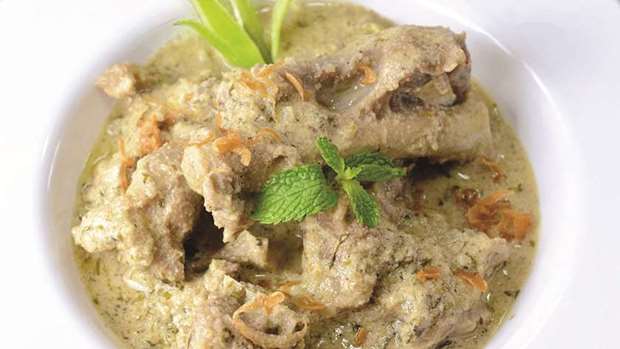Kashmir has always been a special place in my heart. A place where I enjoyed working, learning and was impressed with its food offerings, culture and traditions. Kashmiri food denotes food from the picturesque Kashmir Valleyin the lap of the Himalayas. Kashmir not only offers mesmerising locations but also a wide range of lip smacking and exotic delicacies. Traditionally, rice has remained the staple food for the Kashmir populace, which is most popularly complimented with varied preparations of meat. Kashmiris, including the Brahmin Pandits, are meat eaters and thus a number of appetising and luscious Kashmiri dishes of meat like rogan josh and yakhni are available. While roganjosh has already made its mark and is quite popular, there are other delicious dishes that are equally good and exotic like the yakhni. Varied range of traditional Kashmiri breads like bakarkhani and tea like sheer chai are also popular in the region.
Yakhni is a subtle yogurt and saffron based curry. This silky smooth curry with falling-off-the-bone meat is an absolute treat for non-vegetarians. Team it with a plate of aromatic pulao loaded with dry fruits, and you are sure to never forget this meal in your lifetime. Yes, that’s the power it holds even with its subtle flavouring. Yakhni refers to a light curry or broth which has to include two main ingredients other than the meat - yogurt and saffron (kesar). The yogurt brings in richness to the broth while saffron adds a tempting signature yellow hue and taste. You need to labour a little before being able to relish the slow-cooked dish. It is said that the yakhni came to be known in Kashmir during Akbar’s rule. Yogurt-based meat curries were part of Persian cuisine, and the emperor introduced this style of cooking to his new state when he annexed it in 1586. Akbar in fact influenced various regional cuisines of northern India and now part of Pakistan, which have now evolved to become exclusive cuisines by their own right.
Yakhni dishes are also seen in Greek and Turkish cuisines, but what sets the Kashmiri yakhni apart is the absence of tomatoes. Certain recipes also avoid onions and garlic since the Kashmiri pandits did not use those ingredients in their cooking. At a time when almost all Indian curry recipes included turmeric, onions and tomatoes as base ingredients, yakhni was a class apart in their addition. While originally yakhni meant a light curry made with lamb meat, over the years it has gone on to include chicken and even vegetarian versions like Paneer Yakhni.
So, how is yakhni made? The meat is first cooked along with a handful of spices to acquire an aromatic broth, then the pieces are removed and yoghurt is added and left to simmer. The meat pieces are again added back to the broth and it is slow-cooked for some more time to finally acquire the smooth texture with delicate meat. The spices that are commonly added are fennel seeds, cinnamon, cardamom and cloves, among others. Another application of yakhni is the Yakhni Pulao, where rice is cooked in the broth along with the meat pieces to prepare a delectable meal. It is also referred to as Yakhni Biryani and served commonly with a side of raita.
The Kashmir region offers a wide array of food items and has something for everyone. Particularly, authentic non-veg cuisines made of chicken, mutton and fish, some of which have become hugely popular across the nation. The Kashmiri cuisine is primarily non-vegetarian with of course some exquisite vegetarian dishes on offer are mostly influenced by the traditional cuisines of the Kashmiri pundits and the mughlai cuisines. Culinary styles and trends of regions like Afghanistan, Persia and Central Asia are also noticeable in Kashmiri food. Generally, Kashmiri cuisines, most of which are marked with ample use of turmeric and yogurt are quite rich in flavour and mild in taste. Spices like cloves, cinnamon, cardamom, ginger and fennel which are generally considered hot and are used widely in different Kashmiri dishes, while garlic and onion are not used much. The region that boasts of being the world leading producer as well as exporter of saffron, uses this colouring and seasoning agent as an ingredient in many of its dishes specially sweets and pulao. The exquisite aromatic flavour of variety of dishes of this region, particularly seasoned with saffron, has become an integral part of Kashmiri food, some sort of a trademark, making it more enticing among gastronomic enthusiasts. Dry fruits are also used extensively in different Kashmiri dishes, especially in preparing curries and rice dishes.The unique aromatic flavour of Kashmiri rice has garnered much fame with the Kashmiri pulao topping the rice dishes giving stiff competition to the various other rice delicacies across the nation. Traditionally, ghee is used in cooking Kashmiri dishes, however, in modern day many health conscious Kashmiri families have switched to soybean and olive oil.
The Kashmiri cuisine writeup without the term ‘Wazwan’ is always incomplete. Wazwan is traditional Kashmiri style of cuisine prepared by specialised cooks called Wazaas. This multi-course Kashmiri meal is considered essential for social gatherings and celebrations. The preparation of this cuisine is regarded as an art and the dishes are held with high regards in the region. This multi-course meal traditionally comprise 36 courses of which 15 to 30 can be meat-based. The non-veg items can be prepared out of fish, chicken and lamb but beef is never used. Dishes based on lentils or pulses at the time of this elaborate fest is not preferred. This popular cuisine has made its way not only to the leading hotels and restaurants in India and Pakistan but also to different international Kashmiri food festivals and occasions.
Yakhni gosht
Ingredients
Goat cubes 800 gm
Mustard oil 2 tbsp
Fennel powder 2 tbsp
Salt to taste
Black Cumin seeds 1 tsp
Bay leaves few leaves
Asafoetida ½ tsp
Cloves 5-6 nos.
Cardamom black 5 pods
Cinnamon 1 stick
Yoghurt 3 cups
Ghee 5-6 tbsp
Coriander, chopped 2 tbsp
Method
Wash the goat cubes and drain the water and keep aside
Heat oil in a heavy bottom pan and add the goat cubes
Fry over high heat to seal the goat meat
Add salt and asaf0etida, water and fennel powder, black cardamom, cinnamon stick, bay leaves
Reduce the heat and simmer over slow flame to cook the goat cubes
In a separate pan heat 1 tbsp oil and add black cumin seeds
Add whisked yogurt and bring to boil
Combine this yogurt to the goat mixture and simmer over slow flame
Reduce the heat and sprinkle with chopped coriander leaves
Serve hot with steam rice
Take a frying pan, put remaining oil and heat it till well, remove it from gas and put shah jeera and cloves in it.
Again put the pan back on low flame and stir for one minute, add whisked yogurt and turn flames on high, keep stirring continuously so that it doesn’t curdle till it boils.
Now add this boiling yogurt and pure ghee in the mutton and keep it on low flame for 5-6 minutes.
Turn off the flames and garnish with fresh chopped coriander.
* Chef Tarun Kapoor, Culinary Mastermind, USA. He may be contacted at [email protected]

AROMATIC: Yakhni gosht is served hot with steam rice. Photo by the author


